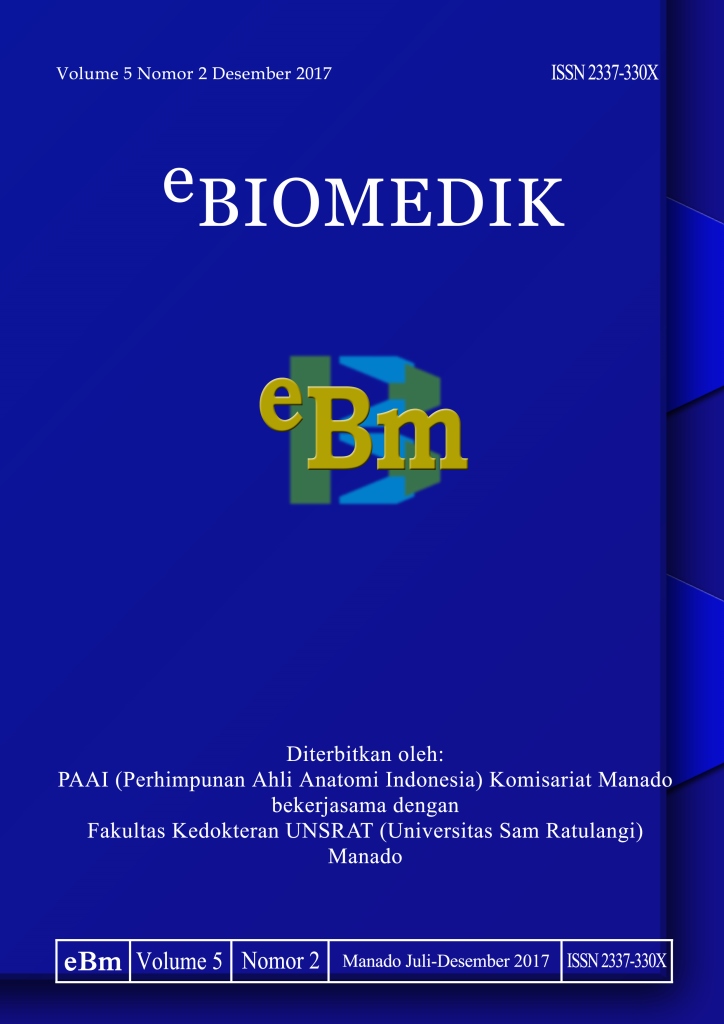Isolasi dan Identifikasi Bakteri Resisten Merkuri melalui Analisis Gen 16S rRNA pada Urin Pasien dengan Tumpatan Amalgam
DOI:
https://doi.org/10.35790/ebm.v5i2.18513Abstract
Abstract: Mercury is a hazardous metal used as the main component of amalgam. Amalgam is a source of the chronic exposure of elemental mercury (Hg0) to human body. In the body, mercury is excreted through urine. Chronic exposure to mercury causes bacteria to develop resistance using mer operon. By analyzing the 16S rRNA gene, the bacterial identification is more specific and able to facilitate further studies about mercury-resistant bacteria within the human body. This study was aimed to identify the mercury-resistant bacteria isolated from the urine of patients with dental amalgam. This was an explorative descriptive study by isolation and identification of mercury-resistant bacteria in the urine samples of patients with dental amalgam and studying the evolutionary relationship through 16S rRNA gene. The nucleotide sequence of 16S rRNA gene of bacteria from urine samples of patients with dental amalgam showed 100% resemblances with Bacillus cereus. The phylogenetic tree showed that Bacillus cereus was closely related to Bacillus anthracis, Bacillus sp., and Bacillus thuringiensis. Conclusion: Mercury-resistant bacteria isolated from urine of patients with dental amalgam was Bacillus cereus, which was not the normal flora of human body. Bacillus cereus had close evolutionary relationship with Bacillus anthracis, Bacillus sp., and Bacillus thuringiensis.
Keywords: mercury-resistant bacteria, 16S rRNA gene, urine, amalgam.
Â
Abstrak: Merkuri adalah logam berbahaya komponen utama pada amalgam. Amalgam merupakan sumber paparan kronis merkuri elemental (Hg0) pada manusia. Di dalam tubuh, merkuri diekskresikan melalui urin. Akibat terpapar merkuri dalam waktu lama, bakteri dalam urin mengembangkan mekanisme resistensi terhadap merkuri melalui operon mer. Melalui analisis gen 16S rRNA, identifikasi bakteri lebih spesifik sehingga mempermudah untuk mempelajari dan meneliti lebih lanjut tentang bakteri resisten merkuri pada tubuh manusia. Penelitian ini bertujuan untuk mengetahui jenis bakteri resisten merkuri yang diisolasi dari urin pasien dengan tumpatan amalgam. Jenis penelitian ialah deskriptif eksploratif, melalui isolasi dan identifikasi bakteri resisten merkuri dari urin pasien pengguna amalgam serta melihat hubungan kekerabatan bakteri tersebut melalui gen 16S rRNA. Hasil penelitian mendapatkan urutan nukleotida gen 16S rRNA bakteri dari urin pasien pengguna amalgam memiliki kesamaan 100% paling banyak dengan Bacillus cereus. Berdasarkan analisis hubungan kekerabatan, Bacillus cereus berkerabat dekat dengan Bacillus anthracis, Bacillus sp, dan Bacillus thuringiensis. Simpulan: Bakteri resisten merkuri yang diisolasi dari sampel urin pasien pengguna amalgam ialah Bacillus cereus, yang bukan merupakan flora normal tubuh manusia. Bacillus cereus memiliki hubungan kekerabatan dekat dengan Bacillus anthracis, Bacillus sp, dan Bacillus thuringiensis.
Kata kunci: bakteri resisten merkuri, gen 16S rRNA, urin, amalgam





